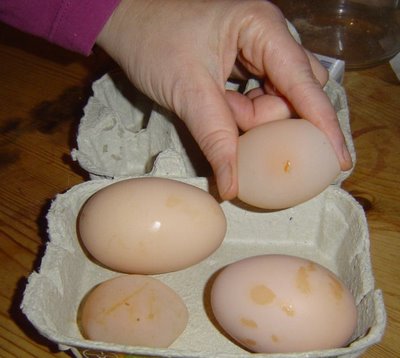
I’d stopped writing an update about our woods to watch the first of Hugh Fernley Whittingstall’s latest series, The River Cottage Treatment on the TV. (We have access to English TV here via satellite). It was excellent and compulsive viewing and so tonight’s blog will be about our chickens … again. For those of you who didn’t see it, this chef/food-journalist-become-organic-farmer/TV presenter is presenting a series during which he tries to change the minds of fast-food loving townies; this programme was specifically about chickens. His guests saw, at first hand, the difference between factory farms and his own free-range flock, learnt how to cook free-range alternatives to their own ready meal favourites such as chicken kiev, curried chicken and spicy chicken bites (no more expensive and no slower!) ending in the killing, preparing and eating of one of his own. For a long time, I’ve thought that any chicken sold in a supermarket for just £2.50 (€3,60/$4.75) doesn’t leave much for the farmer but didn’t realise that the farmer sells them, on average, for just 3p (just over 4 centimes or 5 cents) per bird! Who’s winning here, certainly not the farmer or the chicken?
We’re now into full egg production here and so we keep them in their run until around midday, as chickens usually lay in the morning. The eggs are still variable, from impressively large double-yolkers, through regular to some in soft bags rather than fully-formed shells (see photo above). When let out, the chickens roam far and wide, returning mid-afternoon when we feed them with wheat and maize. Three weeks ago, Caroline gave us another two chicks to add to our flock. We kept them in for a week to habituate them to their new home and whilst they were definitely at the bottom of the pecking order, they returned after their daily outings without any problems … until a couple of days ago. The smallest and cutest was missing! We’ve already lost one chicken recently, perhaps to a fox or dog, and were sorry to see another go. We searched around and spoke to neighbours, without success. It was a full 24 hours later when she turned up at feeding time with the rest of the flock, which made us both unreasonably happy, I must be getting soft.
Chickens will scratch any restricted area bare over time, as ours have done with their run. They get access to fresh grass while they’re out but, as they’re spending a bit more time in during the mornings, we’ve added a thick layer of straw to their run which allows them to satisfy their scratching instincts whilst inside. The inspiration for this is the “Balfour method” of keeping chickens, as described by John Seymour in his The New Complete Guide to Self-Sufficiencyp120. In this method—suitable for a restricted space like a backyard—straw is spread in the pen as described above, with the rest of the space available for the chickens divided into two or three grassed runs with the chickens moved between them before the grass is scratched bare, thereby allowing the grass in the other pens to recover.
On a personal note, my mum tells me that some friends of the family, who have been arable farmers for many years, have started reading our blog. So, Steven and Joan (and anybody else, for that matter) please feel free to offer advice: for instructions on how to post a comment, have a look at the blog for June 28th.
